Shadow theater prop – gunungan / kekayon
Every month curators of the Asia and Pacific Museum carefully select one object representing various parts of our new permanent exhibition Journeys to the east through the cultures of the Middle East, Central Asia, Mongolia and Indonesia.
In June we pay particular attention to a large, yet completely flat and lightweight theatre prop, resembling a mountain or a leaf. It has a triangular outline with concave side edges at the bottom. It is made of dried buffalo leather, precisely cut into small openwork and polychrome. It is two-sided, i.e. on one side we can see a tree with animals on the branches and a gate at the bottom – all that painted with a wide range of colors, and on the other is a stylized flame. The whole thing is embedded in a wooden stick to let the the puppet animator (dalang) use it. The dalang is enlivens the characters and speaks their words.
On the colorful side, one can see figures of a buffalo and a tiger, peacocks, felines and monkeys on a tree among the branches; in addition, the heads of two snakes (Nagas) with opened mouths and in the middle is a menacing mask of Kala (the ruler of time in Indian and Javanese mythology), here a figure with an apotropaic function. At the bottom, on the sides, are two dangerous, symbolic guards with maces.
On the other side there are painted symmetrical spots with intense colors (mainly red) in a regular arrangement – meaning fire.
The gunungan (otherwise: kekayon) is the most important prop of the Javanese wayang kulit shadow theater. It symbolizes the world and and the tree of life. Its outline resembles a mountain (Jav. gunung), and the form painted inside shows a tree (Jav. kayu) – the tree of life from Indonesian mythology, the axis of the cosmos, connecting the sphere of heavens with the earth and the underworld.
There are two varieties of Javanese gunungan / kekayon: one is the gunungan gapuran shown here with a gate in the middle, the other is the gunungan blumbangan – with a pond with fish swimming in it.
Whenever the show starts, the gunungan/kekayon is stuck in the center of the screen, which means the show has not yet started, and symbolically the world has no history yet. After starting a lacon – a play with a specific theme – the gunungan is removed from the center and placed on the right side of the screen. When changing the course of the story or between parts of the story, the gunungan appears in the middle, it is also used as a prop which, when properly moved (accompanied by sound effects), represents natural phenomena such as wind, storm, earthquake, fire and others (red – yellow page). In addition, the dalang uses it when to show that the action takes place in the jungle, and also when in a palace. After the performance is over, it is placed back in the center of the screen.
The shadow theater performance in Java runs all night, with two breaks. There is no permanent theater building, the performance is ordered and paid for for specific occasions. The puppets are illuminated by a single light source and cast a shadow on a white canvas screen. However, they can be viewed both from the side of the shadows and in full colors from behind the dalang’s back and the gamelan orchestra accompanying the performance. Dalang moves to more places with the extensive set of shadow puppets. The audience can come and watch the performance at any time, they can also eat during the performance and leave whenever they want.
Photo by: Łukasz Brodowicz / the Asia and Pacific Museum
Shadow theater prop – gunungan / kekayon
Indonesia, Java, 1st half of the 20th century
buffalo hide, wood
76 with the stick 99 cm; prop itself (hide) H. 76.5 cm; W. 46.5 cm
is in the collection of the MAiP
[inv. no. MAP 1219]
from the founding gift of Andrzej Wawrzyniak, 1973

![grafika z tekstem [journeys to the east]](https://www.muzeumazji.pl/maip/uploads/2022/08/baner_strona_english_tn-1140x220.jpg)





